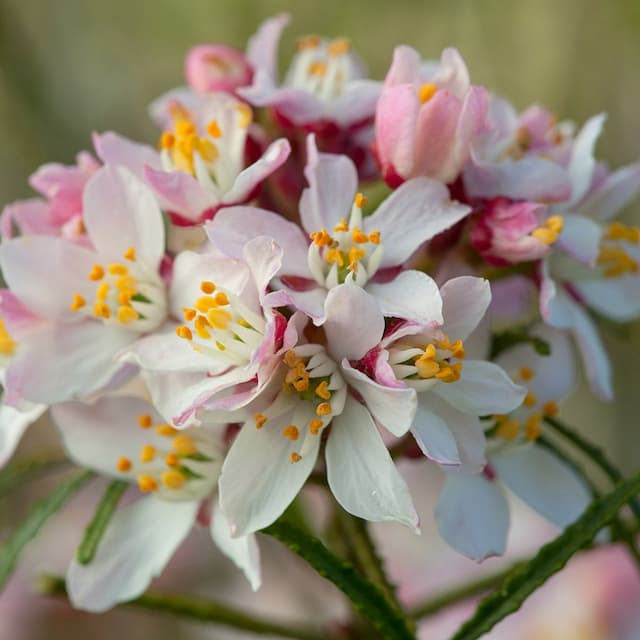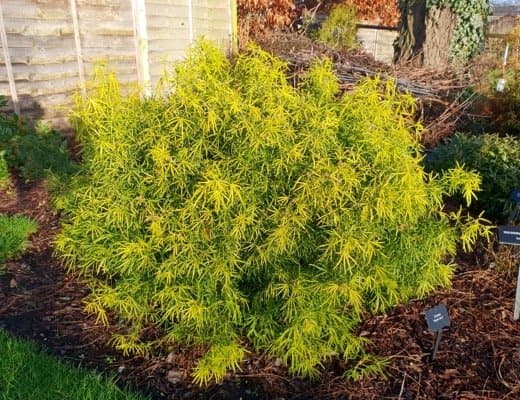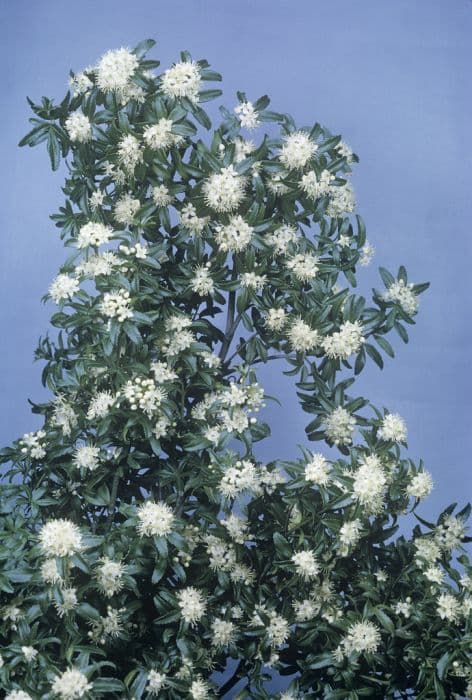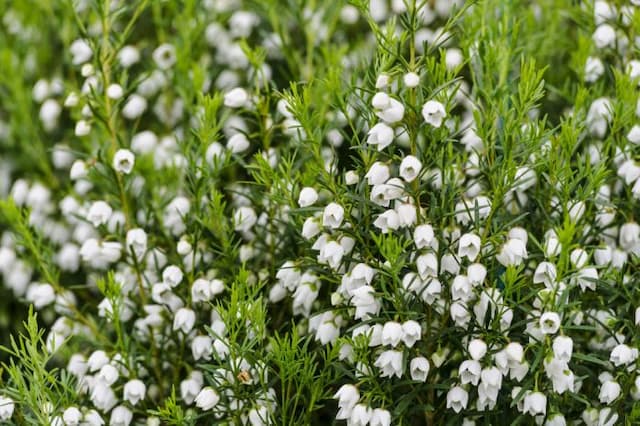Australian Fuchsia Correa backhouseana

ABOUT
The plant commonly known as the Australian fuchsia is an eye-catching evergreen shrub. It showcases a lush display of oval-shaped, dark green foliage that remains vibrant throughout the year. The leaves are soft to the touch, with a slight fuzziness that endows the plant with a somewhat velvety texture. One of the most striking features of the Australian fuchsia is its flowers. These blossoms are typically tubular in shape, exuding a quaint charm with their dusky pink hue that can range to a soft creamy yellow. The flowers dangle delicately from the stems, often appearing in clusters, which adds to the visual spectacle of this plant. The inside of the flower tubes is a sight to behold, often revealing a flurry of stamens that reach out beyond the petals. This intricate detail not only adds depth to the overall aesthetic but also serves as an attraction for various pollinators. The contrast between the dark green leaves and the pastel-colored flowers provides a lovely palette that can lend a serene and natural ambiance to any setting. As the seasons change, the Australian fuchsia may also produce small, inedible fruit, which although not its main feature, does provide additional interest in the garden. The texture of the fruit is another aspect of the plant's tactile allure. Overall, the plant emanates a bushy, organic presence, with its branches generously covered in foliage and interspersed with the charming, bell-like flowers. The Australian fuchsia is a plant that embodies the spirit of the wild, offering a touch of rustic elegance to the landscapes it graces.
About this plant
 Names
NamesFamily
Rutaceae
Synonyms
Backhouse's Correa, Coast Correa
Common names
Correa reflexa var. backhouseana, Correa backhouseana var. typica
 Toxicity
ToxicityTo humans
Correa backhouseana, commonly known as Australian fuchsia, does not have a well-documented profile of toxicity to humans. There is limited information available on its potential toxic effects if ingested. As with any plant, it is generally advisable to avoid ingesting parts of plants that are not commonly consumed as food, especially without adequate knowledge of their edibility and safety. If you suspect poisoning from any plant, seek medical attention.
To pets
Australian fuchsia is not widely recognized for being toxic to pets. However, there is often limited research on the toxicity of specific plants to different animal species. If a pet ingests this plant and exhibits any signs of distress or illness, it is recommended to contact a veterinarian promptly. Symptoms could vary and might include gastrointestinal upset or more severe reactions depending on the amount ingested and the sensitivity of the individual pet.
 Characteristics
CharacteristicsLife cycle
Perennials
Foliage type
Evergreen
Color of leaves
Green
Flower color
Yellow-green
Height
5 feet (1.5 meters)
Spread
6 feet (1.8 meters)
Plant type
Shrub
Hardiness zones
9
Native area
Australia
Benefits
 General Benefits
General Benefits- Wildlife Attraction: Correa backhouseana (Australian fuchsia) is known to attract birds, bees, and other pollinators, enhancing biodiversity in the garden.
- Erosion Control: The plant's dense growth habit can help stabilise soil and prevent erosion on slopes and banks.
- Drought Tolerance: Once established, Australian fuchsia is resistant to drought, making it suitable for water-wise gardens.
- Low Maintenance: It generally requires minimal care, pruning, and feeding, saving time and resources for gardeners.
- Aesthetic Appeal: With its attractive green foliage and tubular flowers, it adds visual interest to landscapes throughout the year.
- Coastal Tolerance: Australian fuchsia can withstand salty winds, making it ideal for coastal planting.
- Habitat Provision: It offers shelter for small wildlife, such as lizards and beneficial insects.
- Frost Resistance: Correa backhouseana can survive light frosts, making it suitable for gardens in cooler climates.
 Medical Properties
Medical PropertiesThis plant is not used for medical purposes.
 Air-purifying Qualities
Air-purifying QualitiesThis plant is not specifically known for air purifying qualities.
 Other Uses
Other Uses- Wildlife Habitat: Correa backhouseana, commonly known as the Backhouse's Correa, provides nectar for hummingbirds, bees, and other nectar-feeding birds and insects during the winter when food can be scarce.
- Soil Erosion Control: The dense and fibrous root system of Backhouse's Correa helps stabilize the soil, making it useful in areas prone to erosion or as a part of revegetation projects.
- Low Hedge: Its compact size and tolerance to pruning make it a natural choice for forming low hedges or borders in gardens or public landscapes.
- Shelter for Small Animals: The thick foliage offers protective cover and suitable nesting sites for small mammals and reptiles.
- Ornamental Use: With its attractive bell-shaped flowers and pleasant foliage, Backhouse's Correa is used for ornamental purposes in gardens.
- Cultural Significance: Indigenous Australians may use the plant in cultural ceremonies or as a part of traditional landscaping practices.
- Education and Conservation: The species can be used in educational settings such as botanical gardens to teach about native flora and conservation efforts.
- Garden Sculpture: Backhouse's Correa can be trained or pruned into various shapes for decorative purposes, resembling living sculptures in the garden.
- Windbreaks: Planting this species in a row can provide a windbreak, protecting other plants in the garden from strong winds.
- Fodder for Livestock: Although not a common use, in times of scarcity, the foliage could potentially be used as emergency fodder for livestock.
Interesting Facts
 Feng Shui
Feng ShuiThe Australian fuchsia is not used in Feng Shui practice.
 Zodiac Sign Compitability
Zodiac Sign CompitabilityThe Australian fuchsia is not used in astrology practice.
 Plant Symbolism
Plant Symbolism- Resilience: Correa backhouseana, commonly known as Australian fuchsia, often grows in tough conditions, symbolizing the ability to thrive amidst adversity.
- Adaptability: The Australian fuchsia's capacity to adapt to various soil types and environments makes it a symbol of versatility and flexibility in life.
- Protection: The dense foliage of the Australian fuchsia can provide shelter for small fauna, thus it is often associated with protection and safety.
- Attraction: With its bell-shaped flowers that attract birds and insects, this plant represents the power of attraction and the importance of relationships in nature.
 Water
WaterFor Australian Fuchsia, it's important to ensure well-drained soil and avoid waterlogging. Typically, water the plant once a week, providing about 1 inch of water to saturate the soil around the roots. In hotter, drier periods, increase watering frequency to twice a week. Cut back on watering in the winter months when the plant's growth slows down. Ensure that the soil is dry to the touch between watering sessions to prevent overwatering.
 Light
LightAustralian Fuchsia prefers a spot that receives full sun to partial shade. While it can tolerate a range of light conditions, the ideal is bright indirect light or dappled sun. Avoid exposing the plant to the harsh afternoon sun which could damage the leaves.
 Temperature
TemperatureAustralian Fuchsia thrives in temperatures between 40°F and 80°F and can tolerate occasional dips to freezing temperatures. However, prolonged exposure to temperatures below 30°F or above 90°F can be detrimental. The plant prefers a cool to moderate climate and can tolerate mild frost.
 Pruning
PruningPruning Australian Fuchsia is beneficial for maintaining shape and promoting healthy growth. Light pruning can be done at any time of the year to remove dead or damaged branches. More substantial pruning is best done in the late winter or early spring before new growth begins to encourage bushier growth and more flowers.
 Cleaning
CleaningAs needed
 Soil
SoilAustralian Fuchsia thrives in well-draining, sandy to loamy soil with added organic matter. It prefers slightly acidic to neutral pH levels, around 6.0 to 7.0. A mix of two parts sand or perlite, one part garden soil, and one part compost or peat moss makes an ideal soil composition for this plant.
 Repotting
RepottingAustralian Fuchsia should typically be repotted every two to three years or when it outgrows its current pot. Younger, faster-growing plants may require more frequent repotting.
 Humidity & Misting
Humidity & MistingAustralian Fuchsia prefers moderate humidity levels but is fairly adaptable. It does not require the high humidity that tropical plants might need and can thrive in typical indoor humidity levels.
 Suitable locations
Suitable locationsIndoor
Place in bright, indirect light and water when topsoil feels dry.
Outdoor
Grow in partial shade and shelter from harsh conditions.
Hardiness zone
9-11 USDA
 Life cycle
Life cycleCorrea backhouseana, commonly known as Backhouse's Australian fuchsia, commences its life cycle as a seed dispersed by gravity or animal activity. Upon finding suitable soil conditions and sufficient moisture, the seed germinates, a process that can be irregular and take several months. The seedling emerges and gradually develops a root system and foliage as it enters the vegetative growth phase. Once mature, which can take several years, it begins its reproductive phase, producing creamy-yellow, bell-shaped flowers primarily in the cooler months, which can attract birds and insects for pollination. Following pollination, the plant produces fruits that are dry and dehiscent, containing numerous seeds ready for dispersal, thus completing the cycle. Correa backhouseana may live for many years, continuously growing and reproducing seasonally within suitable Australian coastal heath and woodland environments.
 Propogation
PropogationPropogation time
Spring to Summer
Correa backhouseana, commonly known as Backhouse's Correa or Australian fuchsia, is generally propagated by semi-hardwood cuttings. The ideal time for this method is during the late summer. To propagate by cuttings, one should select semi-hardwood segments of the current season's growth, typically 4 to 6 inches (about 10 to 15 cm) long, and strip the leaves from the lower half. The cut end can be treated with a rooting hormone to encourage root development and then inserted into a pot containing a mixture of peat and perlite or sand. The pot should be kept in a warm, humid environment but not in direct sunlight, and the medium should be kept moist but not saturated. Roots usually develop within several weeks, after which the new plants can be gradually acclimated to outdoor conditions before planting out.









![Mexican orange [Sundance]](/_next/image?url=https%3A%2F%2Fplants-admin.emdemapps.com%2Fimages%2Fplants%2F%2Fimages%2F604b5381bcf0d.png&w=640&q=75)